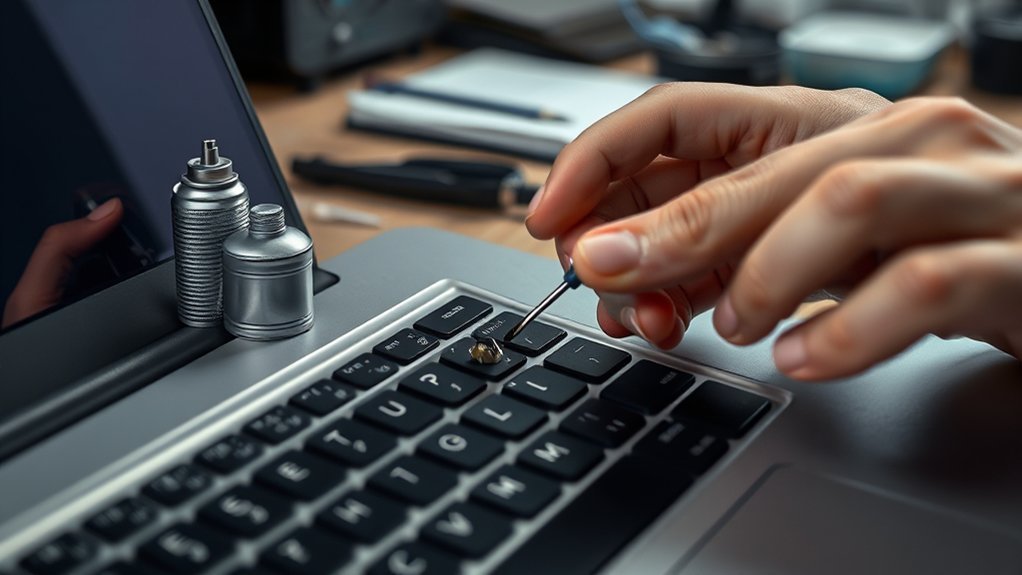If your laptop keyboard isn’t working, don’t panic. Start by rebooting your device to tackle potential software glitches. After that, check for any debris that might be causing issues. If the problem persists, connecting an external keyboard can help you pinpoint whether the issue lies with the built-in keyboard or the operating system. If you discover that the built-in keyboard is faulty, you’ll need to contemplate your next steps.
Reboot and Inspect for Debris
Before diving into more complex solutions, start by rebooting your laptop. This simple step can often resolve temporary software glitches affecting your keyboard functionality.
Once rebooted, inspect the keyboard closely for any visible debris, dirt, or residue that might obstruct key movement. Pay special attention to the Windows key, as it’s frequently used and can impact your workflow.
Inspect your keyboard for debris or residue, especially around the frequently used Windows key, to ensure smooth functionality.
Use a can of compressed air to blow out any dust or crumbs lodged between the keys. If you notice any keys that are sticky or discolored, gently clean them with a slightly damp cloth or isopropyl alcohol on a cotton swab.
Finally, verify no keys are physically stuck or damaged, as this could indicate a hardware issue needing further attention.
Connect an External Keyboard
If inspecting for debris didn’t resolve the keyboard issue, connecting an external keyboard can help diagnose whether the problem lies with the laptop’s built-in keyboard or another component.
Start by plugging the external USB keyboard into an available USB port on your laptop. Confirm it’s securely connected and powered on if necessary.
Once it’s recognized, open a text document or any application and test the external keyboard by typing. If it works flawlessly, your laptop’s built-in keyboard likely has a hardware malfunction.
However, if the external keyboard doesn’t function either, the issue may stem from the laptop’s operating system or drivers. This can help narrow down the problem, leading you to the next steps toward resolution.
Seek Professional Help if Needed
When the built-in keyboard fails and troubleshooting hasn’t resolved the issue, it’s time to seek professional help.
If an external keyboard works while your laptop’s built-in one doesn’t, the problem is likely hardware-related. Document all troubleshooting steps you’ve taken, including resets and driver updates; this will assist technicians in diagnosing the issue efficiently.
Consider taking your laptop to a certified repair shop or contacting the manufacturer’s service center for expert inspection and repairs. If the keyboard is dirty or visibly damaged, professional cleaning or replacement might be necessary.
Always check your warranty status before seeking repairs, as some fixes may be covered. Don’t hesitate to get the expert help you need to restore your laptop’s functionality.
Frequently Asked Questions
How to Fix an Unresponsive Laptop Keyboard?
To fix your unresponsive laptop keyboard, connect an external keyboard, run the keyboard troubleshooter in Windows Settings, check for debris, and if necessary, uninstall and reinstall the keyboard driver. Seek help if problems persist.
How to Fix Random Keys Not Working on Laptop?
When keys on your laptop feel like they’re in shackles, first check for dirt or obstructions. If that doesn’t work, test with an external keyboard, update drivers, and run the Windows troubleshooter for liberation.
How to Force Reset Laptop Keyboard?
To force reset your laptop keyboard, power off the device, disconnect it, hold the power button for 15 seconds, reconnect everything, then power it on. Check if the keyboard responds properly afterward.
How to Fix a Laptop Keyboard That Won’t Type Certain Letters?
Check for debris under the keys, test with an external keyboard, uninstall and reinstall the keyboard driver from Device Manager, and run the built-in troubleshooter to resolve issues with specific letters not typing.
Conclusion
To sum up, fixing your laptop keyboard can be as simple as a quick reboot and a thorough inspection. If the keys still refuse to respond, connecting an external keyboard serves as a reliable bridge to determine the issue. However, if the built-in keyboard remains unyielding, it might be time to call in the experts. Think of your keyboard as a finely tuned instrument; when it’s out of tune, a professional can help restore its harmonious functionality.

